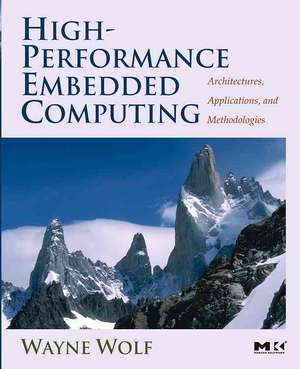High-Performance Embedded Computing: Architectures, Applications, and Methodologies
en Paperback – 31 aug 2006
High-Performance Embedded Computing: Architectures, Applications, and Methodologies is the first book designed to address the needs of advanced students and industry professionals. Focusing on the unique complexities of embedded system design, the book provides a detailed look at advanced topics in the field, including multiprocessors, VLIW and superscalar architectures, and power consumption. Fundamental challenges in embedded computing are described, together with design methodologies and models of computation. HPEC provides an in-depth and advanced treatment of all the components of embedded systems, with discussions of the current developments in the field and numerous examples of real-world applications.
- Covers advanced topics in embedded computing, including multiprocessors, VLIW and superscalar architectures, and power consumption
- Provides in-depth coverage of networks, reconfigurable systems, hardware-software co-design, security, and program analysis
- Includes examples of many real-world embedded computing applications (cell phones, printers, digital video) and architectures (the Freescale Starcore, TI OMAP multiprocessor, the TI C5000 and C6000 series, and others)
Preț: 378.33 lei
Preț vechi: 411.22 lei
-8% Nou
Puncte Express: 567
Preț estimativ în valută:
72.42€ • 78.69$ • 60.87£
72.42€ • 78.69$ • 60.87£
Carte tipărită la comandă
Livrare economică 15-29 aprilie
Preluare comenzi: 021 569.72.76
Specificații
ISBN-13: 9780123694850
ISBN-10: 012369485X
Pagini: 521
Ilustrații: Approx. 280 illustrations
Dimensiuni: 192 x 234 x 34 mm
Greutate: 0.99 kg
Editura: Elsevier
ISBN-10: 012369485X
Pagini: 521
Ilustrații: Approx. 280 illustrations
Dimensiuni: 192 x 234 x 34 mm
Greutate: 0.99 kg
Editura: Elsevier
Public țintă
Sr. undergraduates and graduate students in CS, CE, and EE advanced embedded computing courses; computing professionals in hardware design or software development who are seeking an integrated knowledge of both in order to design embedded systems.Cuprins
1 Embedded Computing
1.1 The Landscape of High-Performance Embedded Computing
1.2 Example Applications
1.3 Design Goals
1.4 Design Methodologies
1.5 Models of Computation
1.6 Reliability, Safety, and Security
1.7 Consumer Electronics Architectures
1.8 Summary and a Look Ahead
What We Learned
Further Reading
Questions
Lab Exercises
2 CPUs
2.1 Introduction
2.2 Comparing Processors
2.3 RISC Processors and Digital Signal Processors
2.4 Parallel Execution Mechanisms
2.5 Variable-Performance CPU Architectures
2.6 Processor Memory Hierarchy
2.7 Additional CPU Mechanisms
2.8 CPU Simulation
2.9 Automated CPU Design
2.10 Summary
What We Learned
Further Reading
Questions
Lab Exercises
3 Programs
3.1 Introduction
3.2 Code Generation and Back-End Compilation
3.3 Memory-Oriented Optimizations
3.4 Program Performance Analysis
3.5 Models of Computation and Programming
3.6 Summary
What We Learned
Further Reading
Questions
Lab Exercises
4 Processes and Operating Systems
4.1 Introduction
4.2 Real-Time Process Scheduling
4.3 Languages and Scheduling
4.4 Operating System Design
4.5 Verification
4.6 Summary
What We Learned
Further Reading
Questions
Lab Exercises
5 Multiprocessor Architectures
5.1 Introduction
5.2 Why Embedded Multiprocessors?
5.3 Multiprocessor Design Techniques
5.4 Multiprocessor Architectures
5.5 Processing Elements
5.6 Interconnection Networks
5.7 Memory Systems
5.8 Physically Distributed Systems and Networks
5.9 Multiprocessor Design Methodologies and Algorithms
5.10 Summary
What We Learned
Further Reading
Questions
Lab Exercises
6 Multiprocessor Software
6.1 Introduction
6.2 What Is Different About Embedded Multiprocessor Software?
6.3 Real-Time Multiprocessor Operating Systems
6.4 Services and Middleware for Embedded Multiprocessors
6.5 Design Verification
6.6 Summary
What We Learned
Further Reading
Questions
Lab Exercises
7 Hardware/Software Co-Design
7.1 Introduction
7.2 Design Platforms
7.3 Performance Analysis
7.4 Hardware/Software Co-Synthesis Algorithms
7.5 Hardware/Software Co-Simulation
7.6 Summary
What We Learned
Further Reading
Questions
Lab Exercises
Glossary
Recenzii
“This book has much to contribute. More and more embedded devices are becoming available, with people walking around with cell phones, PDAs, MP3 players. The design and constraints of these devices is quite different from a generic computing system such as a laptop or desktop PC. This book provides an abundance of information on these basic design topics while also covering newer areas of research such as sensor networks and multiprocessors.
ߝ Mitch Theys, University of Illinois, Chicago
“Developers getting into embedded design will find this book invaluable. Experienced developers wanting to check out the latest tech methodologies will find the book useful as well. Keeping abreast of this information is not an easy task, so it helps to have the insight Wolf provides.
ߝ William Wong, Electronic Design Online, November 1, 2006
ߝ Mitch Theys, University of Illinois, Chicago
“Developers getting into embedded design will find this book invaluable. Experienced developers wanting to check out the latest tech methodologies will find the book useful as well. Keeping abreast of this information is not an easy task, so it helps to have the insight Wolf provides.
ߝ William Wong, Electronic Design Online, November 1, 2006
